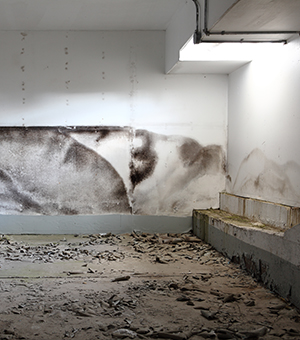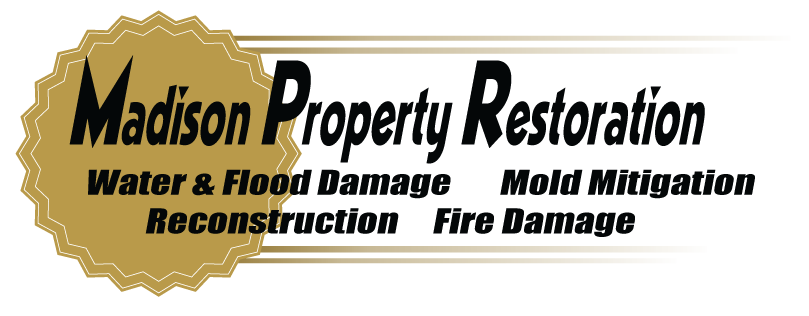With all of the recent flooding experienced in Wisconsin, one of the primary environmental concerns in the aftermath may be mold growing in the properties where floodwater intruded.
Molds have existed for millions of years and grow naturally outdoors. They are fungal organisms essential for the breakdown of dead plant and animal matter. Most molds reproduce by forming microscopic spores not visible to the naked eye that are released into the air. When spores land on a suitable moist surface, they begin to grow; they can penetrate porous materials and release chemicals. Most molds are harmless, but some can cause infections, allergy symptoms and also produce toxins.
Mold spores are everywhere around us — indoors and outdoors — and there is no practical way to keep mold out of a home. Molds can be easily brought into buildings through open windows and doors, ventilation and air conditioning systems, as well as on pets, clothing or shoes. Flooding or water leaks, spills from bathtubs or showers, condensation and other sources of moisture, or humidity may make a home a more likely host for mold. Once indoors, molds grow very easily, only needing moisture and a food source. Damp paper products, lint, ceiling tiles, drywall, wallpaper, insulation, carpeting, fabric, upholstery and wood can all serve as good nutrient sources for mold growth. Mold remediation is often necessary to return living spaces to a safe condition and make them suitable for occupancy.
Impulse to test
When learning of a potential mold issue in a home, the first impulse of most people is to want to test for mold. This is certainly true for buyers in home purchase transactions. They are accustomed to testing for substances like radon, lead, arsenic, E. coli bacteria or nitrates where there is a great deal of science and research from the Environmental Protection Agency (EPA) and state health agencies like the Wisconsin Department of Health Services (DHS). Those agencies have established testing protocols and procedures as well as trigger points where the level or concentration of a harmful substance in the water or ground or paint has been determined to have harmful effects upon the people exposed to the substances. Buyers and other consumers assume they can find out what kinds and quantities of mold are present and that this will be useful information because they expect there will be a scientific chart reporting at what levels certain types of mold are harmful. These buyers may be surprised to learn the Centers for Disease Control and Prevention (CDC), EPA, DHS and other experts across the country actually recommend against spending time and money for mold testing.
No standards
One reason experts generally recommend against mold testing is that there are no EPA or other scientific standards, limits or regulations pinpointing what constitutes an unsafe level of particular molds. There are no current EPA standards for airborne mold contaminants. This was true a dozen years ago and remains true today as there have been no new scientific developments.
That does not mean that there are not contractors willing to take a consumer’s money to test for mold. Different “experts” and contractors may take samples using different testing methods, interpret data in some manner and recommend certain measures to address the problem. But since no safe limits have been set for mold or mold spores, sampling cannot be used to check a building’s compliance with federal mold standards. Standards or threshold limit values (TLVs) for airborne concentrations of mold, or mold spores, do not exist.
Generally, it is not necessary to identify the species of mold. Most authorities recommend a thorough inspection to determine the cause of any mold growth rather than testing. The EPA says, “In most cases, if visible mold growth is present, sampling is unnecessary.” The prompt elimination of the moisture source, removal of the mold and a thorough cleaning are more useful responses than testing, regardless of mold species or concentration.
The DHS also does not recommend testing for mold because federal standards or limits for airborne mold do not exist and because mold testing can be expensive. Their advice is if you see or smell mold, it is present. In any situation, the best approach is to find the water source, fix it, and clean up the mold.
Poor reasons to test for mold
- To find out if there is mold
There is a complex mixture of molds found in all occupied indoor environments, so testing will confirm there is mold. It is better to rely on the old-fashioned methods: do you smell it, and do you see it?
- To identify which type of mold is present
A sampling provides a snapshot of what was present at the specific spot where the sample was taken, but this is not often useful when the recommendation for remediation is basically always the same regardless of the type of mold: remove the water source; remove mold and clean.
- To learn if the mold is toxic
Any mold growth indoors should be safely removed regardless of whether toxigenic species have been found. It simply makes no difference unless a person has a specific health concern associated with mycotoxins.
- To find the cause of health complaints
The full range of health effects caused by molds is poorly understood. Whether health effects will occur depends, for each person, on how much mold gets into their body, the amount and potency of various substances that the mold mixture can contain, and the unique susceptibility of each person to the effects of these substances. Mold tests alone will not determine if a specific problem environment is causing a person’s complaints.
- To determine if the environment is safe
At this time, it is unknown what level of mold is “safe” or how much is necessary to cause health problems for different groups of people. Mold tests cannot measure all the molds in an environment or how much occupants are exposed to.
- To decide how to correct a mold problem
All visible mold growth should be captured and physically removed to the greatest extent practical, and the area should be cleaned. In all cases, fixing the moisture problem is critical.
- To make a party respond to the problem
There is no legal requirement to correct a mold problem in most residential or occupational settings. Obtaining mold test results does not change this fact. While common sense supports the importance of correcting indoor mold problems quickly and effectively, the likelihood is that the owner will have to take remedial action and the buyer will back out of the transaction. Testing may be more helpful to prove to the next buyer that the situation has been effectively remediated.
Mold testing or sampling
Surface sampling may be useful to determine if an area has been adequately cleaned or remediated or may be indicated if a resident or buyer has certain allergies or other health-related reasons for such testing. If there is going to be mold testing, sampling should be conducted by professionals who have specific experience in designing mold sampling protocols, sampling methods and interpreting results. Sample analysis should follow analytical methods recommended by the American Industrial Hygiene Association (AIHA), the American Conference of Governmental Industrial Hygienists (ACGIH) or other professional organizations. Indoor air quality consultants and mold remediation contractors are listed by the DHS at www.dhs.wisconsin.gov/mold/clean.htm.
Health effects
People are exposed to molds every day and everywhere, at home, at work, at school, both indoors and out. Molds are generally not harmful to healthy humans. Inhalation is considered the primary way that people are exposed to mold, which is why people with asthma may be more sensitive to mold in the air. Other susceptible populations may include children and infants, the elderly, or people with existing respiratory conditions or a weakened immune system as the result of chemotherapy or HIV/AIDS. Symptoms of mold sensitivity may include nasal stuffiness, eye irritation, shortness of breath, and wheezing. Infections are rare in healthy individuals and the effect of toxins is still not well understood.
What about “toxic mold”?
To date, no scientific evidence exists to positively link residential exposure to mold with specific health effects. The majority of human exposures to mold toxins have occurred from ingesting moldy food. Some occupations, such as farming and working in greenhouses, where high levels of mold can be encountered, present a risk for workers.
Homebuyer safeguards
When there is a flood or other indicators of possible water intrusion or mold impacting a property in a transaction, the prudent REALTOR® will:
- Provide buyers with information or brochures published by authoritative sources that explain mold causes, health effects and clean-up.
- Point out conditions that may indicate water problems and potential mold situations; make written material adverse fact disclosures of any known moisture and mold problems or conditions not disclosed by the seller in the real estate condition report or not otherwise disclosed to the parties.
- Ask for the seller’s CLUE report as a valuable resource for double checking past events, such as water intrusions.
- The WB-11 Residential Offer to Purchase defines a “test” as “the taking of samples of materials such as soils, water, air or building materials from the Property and the laboratory or other analysis of these materials.” A mold test would not be permitted under the standard inspection contingency. Use a mold testing contingency if a buyer wants to have mold testing performed.
- If the parties clean areas where mold is found, provide them with mold cleaning instructions so they may clean the mold safely.
Debbi Conrad is Senior Attorney and Director of Legal Affairs for the WRA.
Resources












